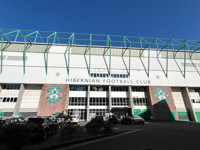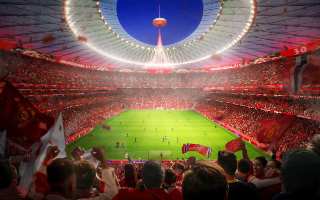Easter Road
| Capacity | 20 421 |
|---|---|
| 84 (VIP seats) | |
| 165 (Press seats) | |
| Country | Scotland |
| City | Edinburgh |
| Clubs | Hibernian FC |
| Other names | The Holy Ground (nickname) |
| Inauguration | 04/02/1893 (Hibernian - Clyde FC) |
| Renovations | 1924, 1954, 1960, 1975, 1980, 1995, 2001, 2010 |
| Record attendance | 65,860 (Hibernian - Hearts FC, 02/01/1950) |
| Address | 12 Albion Place, Edinburgh, EH7 5QG |
Advertisement
Easter Road – stadium description
When Hibs first moved here in 1893, this wasn’t supposed to be their destination ground, rather a step along the way to the desired home stadium. Also for the city of Edinburgh Easter Road was a place for other developments. But after several failed attempts to relocate, Hibernian secured their first long-term lease in 1922, spanning over 25 years.
By 1924 completely new amenities were built here. The field was relocated east to make way for western main grandstand, at that time only one covered. On three other sides large embankments created terracing for roughly 40,000 people, closing the capacity at 45,000.
As the club reached three championships in late 1940s and early 50s, it became apparent the ground is too small. Record attendance for local derby in 1950 reached 65,860, to this day unbeaten football record for any game in Edinburgh. The stadium was thus slightly expanded and even a plan for under-100,000 capacity was drawn, though never implemented.
Floodlights were first lit here in 1954, while in 1980 Easter Road became Scotland’s first to have under-soil heating. Changes in security regulations led to capacity decrease in 1975 and early 1980s, resulting in only 27,000 limit.
As if this wasn’t enough, the Taylor Report forced further restrictions. The club attempted to leave the place for a new stadium, but eventually settled for gradual reconstruction. In 1995 two end zones were built the way we know them today. Then in 2001 new main grandstand and in 2010 the last east stand joined them.
Advertisement
Pictures
-

07.02.2013 © Marian Craig (cc: by-nd) 
24.10.2013 © DncnH (cc: by) 
13.02.2012 © Kyle Smith 
24.08.2010 © David Barlow 
04.09.2024 © Kamil Grabowiec 
24.08.2010 © David Barlow 
24.08.2010 © David Barlow 
24.08.2010 © David Barlow 
24.08.2010 © David Barlow 
01.08.2015 © Paweł Kłoda 
01.08.2015 © Paweł Kłoda 
01.08.2015 © Paweł Kłoda 
29.12.2013 © hnns_schtt 
05.08.2010 © Greg Urquhart (cc: by-nc-nd) 
15.02.2012 © Daniel (cc: by)

 StadiumDB
StadiumDB

